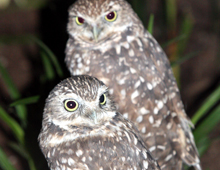Description: The Burrowing owl is a small owl with a round head and no ear tufts. The head, back and wings are sandy in color with white spots. The chest and belly are white to cream color, with spots and bars. The Athene cunicularia has a prominent white chin stripe that is followed by a dark neck stripe, eyebrows are white, eyes and beak are yellow and the legs are long and sparsely feathered. Females are often darker than males.
Size: Burrowing owls measure 8-11 inches (20-28 cm) in body length, weigh approximately 6-8 ounces (170-227 gr) and have a wingspan of 20-24 inches (51-61 cm).
Behavior: The Latin word “Cunicularia” means miner or to mine – a good description for the only owl that lives on the ground in burrows. They are more visible than most owls because they are primarily crepuscular (active at dusk or dawn), but are sometimes active in daylight. Burrowing owls often fly with jerky, irregular wing beats, making frequent long glides. They hover during courtship and hunting and may flap their wings asynchronously (not up and down together). Much of their time is spent perched at the entrance of their burrow.
Diet: Burrowing owls are opportunistic feeders. Their diet consists primarily of large arthropods (beetles, scorpions and grasshoppers) though small mammals (mice, rats, gophers, ground squirrels and rabbits) are also eaten. They will also eat reptiles, amphibians, birds and, unlike other owls, occasionally feed on fruit and seeds. They consume approximately 15% of their body weight each day. They are versatile in capture methods – chase prey on the ground, grab insects in the air with their talons and hover in mid-air before swooping down. They usually search for prey from perches and take food to their burrows to eat.
Senses: The eyes are not capable of moving in the eye sockets, however, the head can rotate almost 270 degrees. Burrowing owls have keen binocular vision but see only in black and white.
Communication: Many sounds, including a “who who” are made by adults, usually associated with breeding or territory defense. Adult sounds are often accompanied by head bobbing. Juveniles give a rattlesnake-sounding buzz when threatened in their burrows.
Reproduction: Athene cunicularia are predominately monogamous birds that sometimes live together in colonies with other burrowing owls. Nests are usually built in abandoned mammal burrows. After careful selection and some renovation, the nest is lined with various dry materials, particularly fecal matter, believed to mask their odor (making detection by predators more difficult) and also serve as insulation for the eggs. If there are no abandoned burrows, they use their bills and long legs to excavate a new burrow. Burrowing owls have one of the largest clutch sizes of any North American raptor, sometimes containing as many as 12 eggs. The incubation period lasts 28-30 days. The female stays at the nest while the male feeds her during the early morning and evening by remaining in close proximity to the nest site. After hatching, care of the young is often done by the male. The chicks stay in the burrow for 10-21 days, when they finally emerge. They gather their own food by eight to nine weeks of age and reach sexual maturity at approximately one year of age.
Habitat/range: Burrowing owls are often found in habitats with burrowing mammals, such as prairie dogs, gophers, skunks and armadillos. They can be found in grasslands, prairies, deserts and open areas (including airports, cemeteries, golf courses and school campuses), from as far north as Saskatchewan and Alberta, Canada, south to the tip of South America (except the Amazon Basin). Burrowing owls, from the northern part of the U.S. and Canada, are migratory.
Status: Listed as Least Concern (LC) on the IUCN Red List; CITES, Appendix II.



